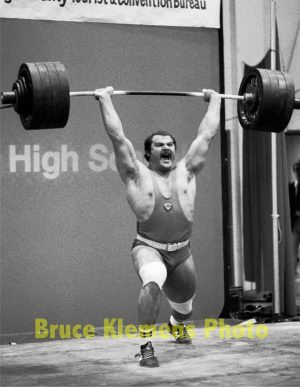 |
| Warning!!! Do not accept eye drops from this man. |
Norm wants to know,
How long would an Olympic bar have to be in order to lift it overhead without the plates ever leaving the ground?Anyone who's ever watched an Olympic weightlifting meet with the super heavies knows the bar bends substantially. The amount it bends depends on a variety of factors (e.g. the mass of the plates, elasticity of the bar, position of the hands, etc.) If we want a large bend, we need a lot of weight. Consider a 260 kg jerk like the one shown below.
 |
| Anatoly Pisarenko jerks 260 kg, courtesy of 70sbig.com |
We can clearly see some curvature to the bar. This curve could take many forms, but for simplicity I'm going to fit it to a parabola.
 |
| Pisarenko's 260 kg jerk with a parabolic fit superimposed on top in red. |
Here, I'm using the width between the plates (which is approximately 1.3 meters) as a measuring stick. All distance measurements from the picture are based off this length. While the bar is not exactly perpendicular to the sightline of the camera, it should be close enough to get an order of magnitude estimate. Just by fiddling with numbers, I visually get a pretty good fit for the form,
h(x) = 2.13 ̶̶̶ 0.1 x2 ,
where h is the height of the bar at a distance x away from the center. The maximum height of the bar is roughly 7 feet. We want to know the length at which the plate will still be touching the ground. Since a 20 kg plate has a radius of about 23 centimeters, we want to know distance x at which the height of the bar is 23 centimeters off the ground. Solving our fitted equation, we find x = ±4.4 meters. Since this is only the distance from the center of the bar to the plate, the total length of the bar will be a little more than twice this, i.e. roughly 9 meters or about 30 feet. By itself, this bar would weigh about 170 pounds.
Thanks, for the great question, Norm. You can check out Weird Lift of the Week and other amusing fitness tidbits at Norm's blog and follow him on Twitter at @mwstrength.
Aaron Santos is a physicist and author of the books How Many Licks? Or How to Estimate Damn Near Anything and Ballparking: Practical Math for Impractical Sports Questions. Follow him on Twitter at @aarontsantos.

No comments:
Post a Comment